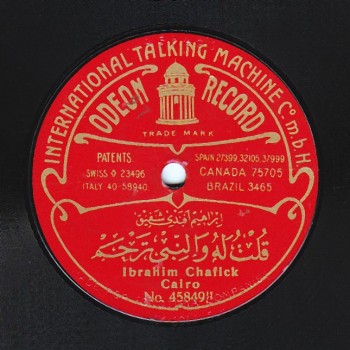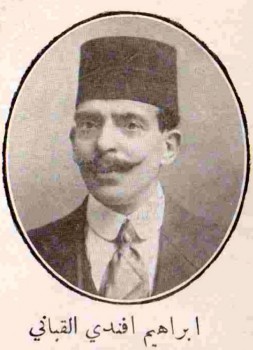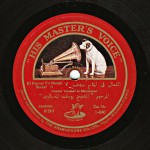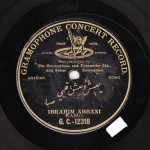 The Arab Music Archiving and Research foundation (AMAR), in collaboration with the Sharjah Art Foundation (SAF), presents “Min al-Tārīkh”.
The Arab Music Archiving and Research foundation (AMAR), in collaboration with the Sharjah Art Foundation (SAF), presents “Min al-Tārīkh”.
Dear listeners, welcome to a new episode of “Min al-Tārīkh”.
In today’s episode, we will resume our discussion about Ibrāhīm al-Qabbānī with Prof. Frédéric Lagrange.
We already covered a large part of his personal life. Let us now talk about his artistic journey.
Ibrāhīm al-Qabbānī’s artistic journey is similar to Dāwūd Ḥusnī’s. More than any other composers and more than any musical tendency in the Egyptian Literary Music school, they both are an extension of Muḥammad ‘Uthmān. This point raises some questions: Ibrāhīm al-Qabbānī is supposed to be influenced by the compositions of Al-Maslūb whom he mingled with and befriended, and whose daughter he married according to our sources. Yet, is there a style one can call “the style of Al-Maslūb” in musical composition?
At the end of the day, ‘Abduh al-Ḥāmūlī and Muḥammad ‘Uthmān are an extension of Al-Maslūb since they developed what he started, which he did not come up with himself, but that came from an important heritage.
Still Al-Maslūb represents the first phase of the dawr…
… until it reached its present form.
He was actually the teacher of ‘Abduh al-Ḥāmūlī and Muḥammad ‘Uthmān.
So, Ibrāhīm al-Qabbānī can’t logically be an extension of Al-Maslūb, even if he studied under him. After Al-Maslūb, something was born from the same core he came out of. Consequently, Ibrāhīm al-Qabbānī continued what was started by Al-Ḥāmūlī and ‘Uthmān.
The extension of the school of ‘Uthmān implies the predominance of the set melody in these dawr, the dawr being a rich and complete work, to such a point that the creative muṭrib could either develop or remove whole sections, such as ‘Abd al-Ḥayy Ḥilmī in dawr “El-bulbul gānī we-allī”, one of Ibrāhīm al-Qabbānī’s most beautiful compositions.
Dawr “El-bulbul gānī” is among the dawr that were recorded a lot as soon as they were composed, i.e. starting early 1903, Dāwūd Ḥusnī –considered as Al-Qabbānī’s competitor– recorded it, added to Sayyid al-Ṣaftī who recorded it the same year, among many others. It is among the mostly recorded dawr by many different muṭrib and thus was apparently considered as an important work even with regards to the period.
Exactly. Moreover, during this period, this musical repertoire was within the reach of all, and all muṭrib had the right to sing this dawr specifically. The catastrophe that hit Ibrāhīm al-Qabbānī was probably his agreement with Gramophone: not only because Gramophone claimed that it had bought all his works –recorded by many muṭrib for other record companies such as Odeon and Baidaphon–, but also because it stipulated that he could only compose for Gramophone. So a muṭrib who had not signed a contract with Gramophone was not allowed to record Al-Qabbānī’s new melodies after this agreement. This contradicts the concept itself of literary music, i.e. the sharing of the musical heritage.
Creative commons…
…Creative commons exactly.
Fortunately for Al-Qabbānī, he had composed dawr “El-bulbul gānī we-allī” before this agreement and before the record companies entered the Middle East. And this beautiful tune was probably recorded by that many muṭrib because it was the major hit in the late 19th century.
Qasṭandī Rizq said that even ‘Abduh al-Ḥāmūlī sang it.
This is a major acknowledgement.
Let us listen to dawr “El-bulbul gānī”. Whose performance shall we listen to?
Let us listen to dawr “El-bulbul gānī we-allī” first by “trustworthy muṭrib” Sheikh Sayyid al-Ṣaftī, then compare his interpretation with ‘Abd al-Ḥayy Ḥilmī’s, noting the latter’s policy consisting in removing sections and only choosing the right ones for a purely ṭarab performance.
Then let us listen a little to Sayyid al-Ṣaftī then a little to ‘Abd al-Ḥayy Ḥilmī…
(♩)
“El-bulbul gānī we-allī” includes some musical aspects that are only developed by specific muṭrib, such as in Sulaymān Abū Dāwūd’s performance…
Sulaymān Abū Dāwūd’s “Yā hal tara nirga‘ el-awṭān”…
For example…
(♩)
As well as Yūsuf al-Manyalāwī’s performance of “Nōḥ el-ḥamām” including his famous ornamentation… We could listen to an excerpt…
(♩)
Other great dawr include “El-kamāl fi-el-milāḥ ṣudaf” and “Abli mā tlūf bi-el-maḥabba”.
I would like to discuss the subject of the rarely used maqām, the un-tackled maqām, and those said to be of a Turkish inspiration, i.e. considered as Ottoman more so that Arabic. The early 20th century or the late 19th century witnessed some competition as to the use of these maqām never used by ‘Abduh al-Ḥāmūlī and Muḥammad ‘Uthmān to compose a whole dawr.
Dāwūd Ḥusnī and Ibrāhīm al-Qabbānī tried their luck at these maqām: one composed a melody and the other one had to answer back with another melody, such as the 2 dawr to the bastanikār: Al-Qabbānī composed “Ultiluh we-el-nabī tirḥam”. Yet these works show that these maqām were initially passing genres probably heard in the performance of a specific work. The bastanikār genre that implies the use of both sīkāh and ṣabā is heard in Kuran reciting, isn’t it?
Yes, as well as in other performances, such as in the only recording we have of ‘Abduh al-Ḥāmūlī made by Meshian of “Anā albī ‘alēk”.
Yes, in “El-bu‘di yāmā”… So the bastanikār may be a passing genre…
… or an ornamentation to the sīkāh and the ṣabā.
Exactly. The novelty consisted in composing a whole dawr to this maqām.
Now, the second remark: Is the dawr actually to the bastanikār? Listening to it shows maybe one phrase and a conclusion to the bastanikār … yet the concept of one maqām is inexistent.
Anyway, all works composed to sub-maqām, even in Turkey, are not fully to this maqām. For example Jamīl Bēk al-Ṭanbūrī’s samā‘ī muḥayyar starts to the muḥayyar then shifts. The point is: no work can be fully composed to any of the sub-maqām that are basically derived from an original maqām.
True. Still, the bastanikār could have been more present. Compare for example “Ultiluh we-el-nabī tirḥam” –which we will listen to an excerpt of– with Munīra al-Mahdiyya’s ṭaqṭūqa composed to the bastanikār …
…“Ḥubbak yā sīdī ghaṭṭa ‘a-el-kull”.
The maqām’s presence is obvious and predominant.
Right, Mr. Frédéric, but ṭaqṭūqa “Ḥubbak yā sīdī ghaṭṭa ‘a-el-kull” does not exceed two sentences, while dawr require a tafrīd, waḥāyid, and henk. A melody of such length can hardly be composed to one sub-maqām, whereas the ṭaqṭūqa is one melody and a repetitive branch and makes it easy to use only one sub-maqām, the bastanikār. Sayyid Darwīsh is the only one who attempted to sing a whole work to the bastanikār specifically, “ ‘Ishi’t ḥusnak”, but he also shifted in the end.
Then it was only artistic showing-off: they would decide to compose a dawr to the bastanikār, the ḥijāz kār kurd, the sāzkār, or to any maqām of an Ottoman inspiration and end up with a beautiful dawr, yet not to this maqām as claimed.
True. And whether we like it or not, regardless of our preference or dislike, it was a “trend”.
Undoubtedly. Even the competition between Dāwūd Ḥusnī and Ibrāhīm al-Qabbānī, each composing a dawr to this maqām, was also a trend, as well as commercial–not in a pejorative sense– to a certain extent.
Now, since we are talking about the bastanikār, let us end today’s episode with a different voice: let us listen to dawr “Ultiluh we-el-nabī tirḥam” performed by Ibrāhīm Shafīq and recorded by Odeon with the takht of Ibrāhīm Afandī Sahlūn and Muḥammad Afandī Ibrāhīm.
We will meet again in a new episode of “Min al-Tārīkh” to resume our discussion about Ibrāhīm al-Qabbānī.
Now let us listen to Ibrāhīm Shafīq…
(♩)
“Min al-Tārīkh” is brought to you by Mustafa Said.
- 221 – Zakariyya Ahmed – 12 (1/9/2022)
- 220 – Zakariyya Ahmed – 11 (1/9/2022)
- 219 – Zakariyya Ahmed – 10 (11/25/2021)
- 218 – Zakariyya Ahmed – 9 (10/26/2021)
- 217 – Zakariyya Ahmed – 8 (9/24/2021)
- 216 – Zakariyya Ahmed – 7 (9/4/2021)
- 215 – Zakariyya Ahmed – 6 (8/28/2021)
- 214 – Zakariyya Ahmed – 5 (8/6/2021)
- 213 – Zakariyya Ahmed – 4 (6/26/2021)
- 212 – Zakariyya Ahmed – 3 (5/27/2021)
- 211 – Zakariyya Ahmed – 2 (5/1/2021)
- 210 – Zakariyya Ahmed – 1 (4/28/2021)
- 209 – W-al-Lāhi lā astaṭī‘u ṣaddak 2 (4/6/2017)
- 208 – W-al-Lāhi lā astaṭī‘u ṣaddak 1 (3/30/2017)
- 207 – Bashraf qarah baṭāq 7 (3/23/2017)



